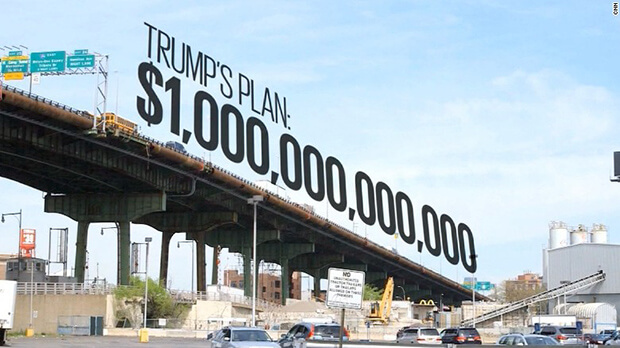Trump's $1 Trillion Infrastructure Plan And What It May Mean For Autonomous Cars

President Donald Trump has unveiled a massive $1 trillion dollar infrastructure spending package. During a speech to Congress in February, Trump declared:
“Crumbling infrastructure will be replaced with new roads, bridges, tunnels, airports and railways gleaming across our beautiful land,”
Elaine Chao, who is the Transportation Secretary for the first time put numbers behind the proposal. Chao told the Senate Environment and Public Works Committee that:
“the proposal will likely include $200 billion in direct federal funds which will be used to leverage $1 trillion in infrastructure investment over the next 10 years,”
She went on to say, that the “principles” of the infrastructure package would be revealed by the end of the month.
The White House infrastructure plan will include $200 billion in federal infrastructure spending over the next decade in an effort to encourage $800 billion in added investment from private, state and local sources. 
The infrastructure plan will also promote public-private partnerships to reach the estimated $1 trillion through global private capital investments.
An infrastructure task force made up of 16 federal agencies and departments will be set up to streamline environmental regulations and fast-track the projects.
While self-driving car advocates are pushing for roadway improvements, Chao said that a broad classification of infrastructure will be targeted, including everything from airports to veterans’ hospitals but she added that the initial rollout of the plan “will not specify any list of projects.”
As evidenced by an embarrassing moment at the LA Auto Show last year when a prototype Volvo autonomous vehicle carrying LA mayor Eric Garcetti couldn’t collect enough visual data to move forward smoothly, even the most basic aspects of the nation’s roadway infrastructure will need upgrading before fully self-driving cars can be successfully deployed.
Avery Ash who is an autonomous vehicle market strategist for Inrix said:
“We need to ensure lane striping is clear so a self-driving car’s cameras can recognize them and invest in consistent signage,”

Author

Justin Kavanagh
Justin Kavanagh is a recognised leader
in automotive intelligence and vehicle
data supply to the entire motor industry.
He has almost 20 years experience in
building systems from the ground up.
As the Managing Director of Vehicle
Management System, he understands the
need and importance of trustworthy and
reliable vehicle history and advice to
both the trade and the public.
Follow me on LinkedIn